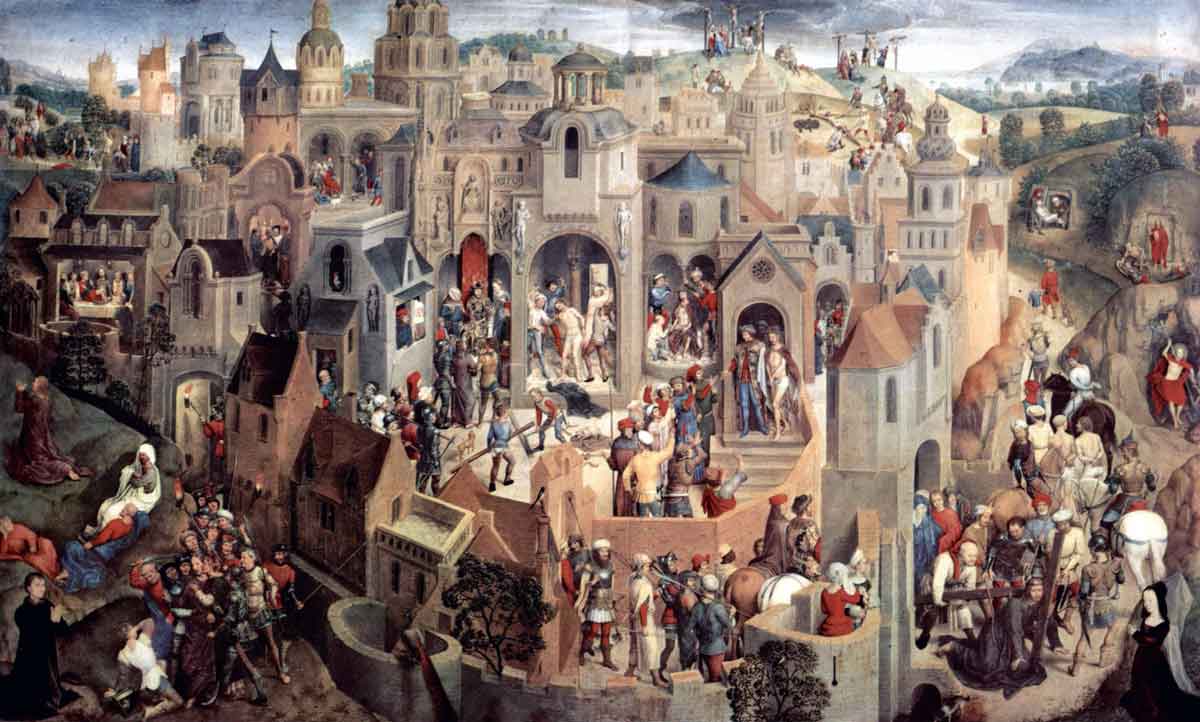APRIL 7, 2024 – SECOND SUNDAY OF EASTER – ST. HEGESIPPUS, A PRIMITIVE FATHER, AND BLESSED HERMAN JOSEPH OF STEINFELD.
- St. John Baptist de la Salle (1719). Priest, Founder or Foundress. (Current) Founder of Brothers of Christian Schools
- St. Herman Joseph (1241). Priest, Religious. (Historical)
HE was by birth a Jew, and belonged to the Church of Jerusalem, but travelling to Rome, he lived there nearly twenty years, from the Pontificate of Anicetus to that of Eleutherius, in 177, when he returned into the East, where he died at an advanced age, probably at Jerusalem, in the year of Christ 180, according to the chronicle of Alexandria. He wrote in the year 133 a History of the Church in five books, from the Passion of Christ down to his own time, the loss of which work is extremely regretted. In it he gave illustrious proofs of his faith, and showed the Apostolical tradition, and that though certain men had disturbed the Church by broaching heresies, yet down to his time, no episcopal see or particular Church had fallen into error. This testimony he gave after having personally visited all the principal Churches, both of the East and West.

BLESSED HERMAN JOSEPH OF STEINFELD.
HERMAN from his earliest years was a devoted client of the Mother of God. As a little child he used to spend all his play-time in the church at Cologne before an image of Mary, where he received many favors. One bitter winter day, as little Herman was coming barefooted into church, his heavenly Mother appearing to him, asked him lovingly why his feet were bare in such cold weather “Alas! dear Lady,” he said, “it is because my parents are so poor.” She pointed to a stone, telling him to look beneath it; there he found four silver pieces wherewith to buy shoes; he did not forget to return and thank her. She enjoined him to go to the same spot in all his wants, and disappeared. Never did the supply fail him; but his comrades, moved by a different spirit, could find nothing. Once our Lady stretched out her hand, and took an apple which the boy offered her in pledge of his love. Another time he saw her high up in the tribune, with the Holy Child and St. John; he longed to join them, but saw no way of doing so; suddenly he found himself placed by their side, and holding sweet converse with the Infant Jesus. At the age of twelve he entered the Premonstratensian house at Steinfeld, and there led an angelic life of purity and prayer. His fellow novices, seeing what graces he received from Mary, called him Joseph; and when he shrank from so high an honor, our Lady in a vision took him as her spouse, and bade him bear the name. Jealously she reproved the smallest faults in her be trothed, and once appeared to him as an old woman to upbraid him for some slight want of devotion. As her dowry, she conferred on him the most cruel sufferings of mind and body, which were especially severe on the great feasts of the Church. But with the cross Mary brought him the grace to bear it bravely, and thus his heart was weaned from earthly things, and he was made ready for his early and saintly death, which took place about the year 1230.
REFLECTION: Do not approach our Blessed Mother with set prayers only. Be intimate with her; confide in her; commend to her every want and every project, small as well as great. It is a childlike reliance and a trustful appeal which she delights to reward.
WORD OF THE DAY
HOLY COAT. The seamless garment of Christ (John 19) for which the soldiers cast lots on Calvary. Two cities both claim to possess this garment. Trier in Germany claims that its relic was sent there by St. Helena (255-330), and is substantiated by a tablet of the sixth century and several documents of the twelfth century. The coat of Argenteuil in France is mentioned in a document dating from 1156 as the cappa pueri Jesu (garment of the Child Jesus). Because of these two traditions the legend arose that the garment woven by the Blessed Virgin and worn by the Savior grew with him. Advocates of the Argenteuil relic say that the Trier coat is not the seamless garment mentioned in the Gospels but an outer cloak. Both relics are the object of popular pilgrimages.
Modern Catholic Dictionary, Fr. John Hardon SJ (Get the real one at Eternal Life — don’t accept an abridged or edited version of this masterpiece!)
EASTER MEDITATIONS
Enjoy daily meditations this Easter from Fr. Richard Clarke, SJ. Short and powerful, written in 1880 for busy lay people to reap rewards through Eastertide: 9.— The Appearance of Jesus to the Holy Women.
This article, APRIL 7, 2024 – SECOND SUNDAY OF EASTER – ST. HEGESIPPUS, A PRIMITIVE FATHER, AND BLESSED HERMAN JOSEPH OF STEINFELD. is a post from The Bellarmine Forum.
https://bellarmineforum.org/april-7-2024-second-sunday-of-easter-st-hegesippus-a-primitive-father-and-blessed-herman-joseph-of-steinfeld/
Do not repost the entire article without written permission. Reasonable excerpts may be reposted so long as it is linked to this page.

